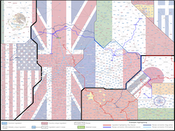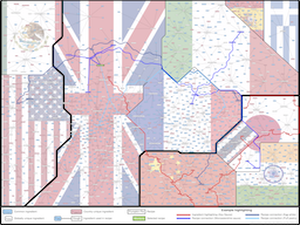Information
- Publication Type: Unknown Publication
- Workgroup(s)/Project(s):
- Date: 2019
Abstract
This poster visualises the Meal Ingredients dataset with 151 international food recipes and their corresponding ingredients. The underlying graph layout in the image is automatically generated using a new multi-level force-based algorithm developed by the authors, but not yet published. The background flags were added manually to identify the countries from the data set. The algorithm aims to untangle mutually nested subgraphs by harmonizing the available space for the labels and improving edge visibility by duplicating high-frequency ingredient nodes. Ingredients occurring in multiple countries also receive at least one node per country. The idea is inspired by map diagrams, which often show the semantics enclosed by country boundaries. In our diagram, countries are represented by octolinear polygons, and are placed next to each other if they share many ingredients in their recipes. The actual placement of the countries by the algorithm is entirely data driven. As we can see, this design naturally gathers countries that are located on the same continent, due to the accessibility of the ingredients. The names of recipes are visualized using textual labels with sharp corners, and they are enclosed by the country polygon they belong to. Contrarily, ingredients are represented by textual labels with rounded corners. Moreover, ingredients are visually classified into common (pink) and special (blue) ingredients based on their frequency in the dataset.
For visually analyzing the data set, we can generate smoothed spanning trees along the boundaries of an (invisible) Voronoi diagram of all textual labels to connect identical nodes to visually integrate all copies of one ingredient. For example, we highlighted the ingredient "soy sauce", one of the most commonly used ingredients in Asia, to discover that it has spread to the UK as well. We can also perform visual queries for related recipes based on sharing rare ingredients. For example, the British dish "steak and kidney pie" is highlighted in green together with three blue spanning trees connecting all recipes related to that dish via at least one of its special (blue) ingredients.
Additional Files and Images
Additional images and videos
Additional files
Weblinks
BibTeX
@unknown{li-2019-gdc,
title = "World map of recipes",
author = "Guangping Li and Soeren Nickel and Martin N\"{o}llenburg and
Ivan Viola and Hsiang-Yun Wu",
year = "2019",
abstract = "This poster visualises the Meal Ingredients dataset with 151
international food recipes and their corresponding
ingredients. The underlying graph layout in the image is
automatically generated using a new multi-level force-based
algorithm developed by the authors, but not yet published.
The background flags were added manually to identify the
countries from the data set. The algorithm aims to untangle
mutually nested subgraphs by harmonizing the available space
for the labels and improving edge visibility by duplicating
high-frequency ingredient nodes. Ingredients occurring in
multiple countries also receive at least one node per
country. The idea is inspired by map diagrams, which often
show the semantics enclosed by country boundaries. In our
diagram, countries are represented by octolinear polygons,
and are placed next to each other if they share many
ingredients in their recipes. The actual placement of the
countries by the algorithm is entirely data driven. As we
can see, this design naturally gathers countries that are
located on the same continent, due to the accessibility of
the ingredients. The names of recipes are visualized using
textual labels with sharp corners, and they are enclosed by
the country polygon they belong to. Contrarily, ingredients
are represented by textual labels with rounded corners.
Moreover, ingredients are visually classified into common
(pink) and special (blue) ingredients based on their
frequency in the dataset. For visually analyzing the data
set, we can generate smoothed spanning trees along the
boundaries of an (invisible) Voronoi diagram of all textual
labels to connect identical nodes to visually integrate all
copies of one ingredient. For example, we highlighted the
ingredient "soy sauce", one of the most commonly used
ingredients in Asia, to discover that it has spread to the
UK as well. We can also perform visual queries for related
recipes based on sharing rare ingredients. For example, the
British dish "steak and kidney pie" is highlighted in green
together with three blue spanning trees connecting all
recipes related to that dish via at least one of its special
(blue) ingredients.",
month = sep,
URL = "https://www.cg.tuwien.ac.at/research/publications/2019/li-2019-gdc/",
}
 image:
1st Place Award, Creative Topic-"Meal Ingredients", of the 28th Annual Graph Drawing Contest
image:
1st Place Award, Creative Topic-"Meal Ingredients", of the 28th Annual Graph Drawing Contest


 poster
poster